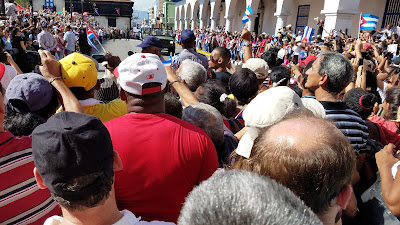Press Release
|
|
Contact: Ruth
Behar 734-747-9197
|
FOR IMMEDIATE RELEASE
February 22, 2016
|
Celebration of Jewish Culture in
Cuba
Celebración de la cultura judía en
Cuba
March 3-4, 2017
ANN
ARBOR, MI: The first public celebration
of Jewish culture in Cuba will be a landmark event bringing together music,
dance, opera, and literature. The idea originated with MacArthur Genius
recipient and prize-winning scholar and writer Ruth Behar, who has been
promoting cultural and artistic bridges between Cuba and the United States for
over twenty years. Ruth is a renowned expert on the history and culture of the
Jews of Cuba and wanted to share with a wide public the vibrancy of the Jewish
Cuban heritage on the island.
The highlight of the celebration
will be the premiere on March 3rd of the Yiddish-Cuban opera, Hatuey:
Memory of Fire. The opera is based on a 1931 epic poem by the Ukranian-Jewish
immigrant writer, Usher Penn (Oscar Pinis in Cuba), penned after he arrived to
safety in Cuba. With the memory of the pogroms in Europe still fresh in his
mind, Penn wrote about the suffering of the indigenous people of Cuba and their
resistance to Spanish domination.
In a unique
collaboration, La Opera de la Calle in Havana, which aims to make opera
accessible to all Cubans, will perform the work, teaming up with American
artists, drawing on the stunning libretto by Elise Thoron, original music by
Grammy-award winning musician Frank London, and production support from Diane
Wondisford and Michael Posnick, son-in-law of the author Usher Penn.
Ruth Behar met Michael
Posnick in Havana in May, 2016. When Michael told her about the dream of bring Hatuey: Memory of Fire to the Cuban
stage, Ruth Behar was determined to help make this dream come true. Her own
maternal grandparents were Yiddish-speaking immigrants from Poland. Staging a
Yiddish-Cuban opera in Cuba seemed an ideal way to honor the kindness and
tolerance with which Cubans had welcomed Jewish immigrants to the island in the
early decades of the twentieth century.
Ruth Behar reached out
directly to Ulises Aquino, the director of La Opera de la Calle, in June, 2016
to ask if he would be interested in staging the work with his company. His
immediate reply was enthusiastic, saying he was interested in considering the
project. Ruth then arranged for a meeting in New York in August, 2016 with
Elise Thoron, Frank London, Michael Posnick, and Diane Wondisford, and the
opera project was launched.
The excitement
surrounding the Hatuey production has garnered attention in the New York Times:
The Cuban press has
also written favorably about the project:
A concert of Klezmer
and Sephardic music at the Patronato Synagogue on March 4th from 3-5pm will continue
the celebration, featuring the Yuval Ron Ensemble and Frank London’s New York
Mishpokhe playing separate concerts and ending with a joint jam session.
Ruth
Behar, a professor of anthropology at the University of Michigan, was born in Havana
and immigrated with her Jewish-Cuban family to New York as a child in the early
1960s. She has been returning to the island for twenty-five years of cultural
bridge-building, and has formed close ties with the Jewish community of Cuba.
Ruth is the author of An Island Called
Home: Returning to Jewish Cuba, among other books. For more information,
please visit http://www.ruthbehar.com/
A special concert of Yiddish and Sephardic music at the Patronato Synagogue
with
the Yuval Ron Ensemble and
Frank London's New York Yiddish Mishpokhe
Saturday, March 4,2017
Yuval Ron and his ensemble will perform a concert of Sephardic music with guest Cuban children's choir Coro Lucecita.
Frank London's New York Yiddish Mishpokhe, to include Sarah Gordon and Zoe Christiansen, will perform klezmer music and Yiddish songs with special Cuban guests.
Frank London's New York Yiddish Mishpokhe, to include Sarah Gordon and Zoe Christiansen, will perform klezmer music and Yiddish songs with special Cuban guests.
A video of the premier of "Hatuey; Memory of
Fire" in Havana by Opera de la Calle can be
seen by clicking here
https://www.youtube.com/watch?v=zQOcVSAEpOU
For more background by librettist Elise Thoron, click here
https://elisethoron.com/hatuey.html







